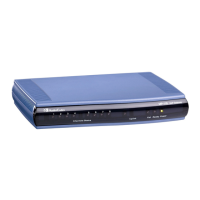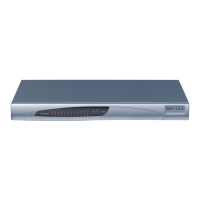Parameter Description
EMS: ETSI Caller ID Type One Sub
Standard
[ETSICallerIDTypeOneSubStanda
rd]
Determines the ETSI FSK Caller ID Type 1 sub-standard (FXS
only).
[0] = (Default) ETSI between rings.
[1] = ETSI before ring DT_AS.
[2] = ETSI before ring RP_AS.
[3] = ETSI before ring LR_DT_AS.
[4] = ETSI not ring related DT_AS.
[5] = ETSI not ring related RP_AS.
[6] = ETSI not ring related LR_DT_AS.
Note: For this parameter to take effect, a device reset is
required.
Web: Asserted Identity Mode
EMS: Asserted ID Mode
[AssertedIdMode]
Determines whether the SIP header P-Asserted-Identity or P-
Preferred-Identity is used in the generated INVITE request for
Caller ID (or privacy).
[0] Disabled = (Default) None
[1] Adding PAsserted Identity
[2] Adding PPreferred Identity
This parameter determines the header (P-Asserted-Identity or
P-Preferred-Identity) used in the generated INVITE request.
The header also depends on the calling Privacy (allowed or
restricted).
These headers are used to present the originating party's
Caller ID. The Caller ID is composed of a Calling Number and
(optionally), a Calling Name.
These headers are used together with the Privacy header. If
Caller ID is restricted (i.e., P-Asserted-Identity is not sent), the
Privacy header includes the value 'id' ('Privacy: id'). Otherwise,
for allowed Caller ID, 'Privacy: none' is used. If Caller ID is
restricted (received from Tel or configured in the device), the
From header is set to <anonymous@anonymous.invalid>.
Web/EMS: Use Destination As
Connected Number
[UseDestinationAsConnectedNu
mber]
Enables the device to include the Called Party Number, from
outgoing Tel calls (after number manipulation), in the SIP P-
Asserted-Identity header. The device includes the SIP P-
Asserted-Identity header in 180 Ringing and 200 OK responses
for IP-to-Tel calls.
[0] Disable (default)
[1] Enable
Notes:
For this feature, you must also enable the device to include
the P-Asserted-Identity header in 180/200 OK responses,
by setting the parameter AssertedIDMode to 1.
This parameter is applicable to FXO interfaces.
Web: Caller ID Transport Type
EMS: Transport Type
[CallerIDTransportType]
Determines the device's behavior for Caller ID detection.
[0] Disable = The caller ID signal is not detected - DTMF
digits remain in the voice stream.
[1] Relay = (Currently not applicable.)
[3]

